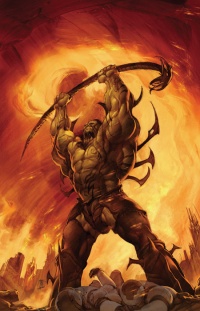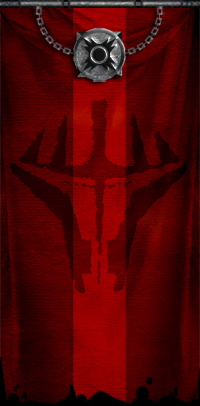- "Who we are is not important--our message is."
- ―IHR
House Revan existed between 30 ABY and 35 ABY. Founded as an Independent House in the wake of the Ninth Great Jedi War under the leadership of Raken and Grand Master Sarin and the support of several other founding members, the group surged to victory during the Battle of Salas V.
Following the Tenth Great Jedi War, the House splintered and officially dissolved. While many of its members remain rogue, many members have assimilated into other houses and clans and maintain their heritage as Revanites.
History
Foundation
The Shadow of Revan
 Dark Lord of the Sith
Dark Lord of the Sith
Tales spread throughout the House around the time of its inception that House Revan was tied to the eponymous Dark Lord of the Sith Darth Revan, predating the foundation of the House by 4,000 years.
According to unauthenticated texts, the original Star Chamber was visited by a figure that many believe was Revan himself. His presence in the system around 3,600 BBY challenges reclaimed records from the Second Great Galactic War. The arrival of this figure was speculated to have triggered a series of events that led ultimately to the Yuuzhan Vong Incursion of the Eighth Great Jedi War.
The relationship between House Revan and Darth Revan, much like the historical connection between the Brotherhood and the Dark Lord, is subject to individual perspective.
- "Darth Revan: ancient, powerful, dead... We're not waiting for any messiah's return to show us the way to the promised land. We'll plot a way there ourselves... Why do you want to be a member of Revan? What are you going to bring to the table?... the old Sith Lord did things his own way. We don't worship him, or anyone for that matter.""
- ―Sarin
Unification
In the final days of the Ninth Great Jedi War, Grand Master Sarin was killed at the hands of the dichotomous Jedi Master Omancor Crask. The war's closure came shortly after as Crask was killed by his own disciple. The Iron Throne was quickly occupied by Sarin's Shadow Hand Muz Ashen as the Brotherhood forces began to hunt down the remains of Crask's army. The whispers of Sarin's death faded underneath the apparent victory.
 Yuuzhan Vong Slayer sows destruction at Southern Command
Yuuzhan Vong Slayer sows destruction at Southern Command
Some in the Dark Brotherhood's courts suspected that the newly enthroned Ashen had a hand in Sarin's fall. Whether Ashen turned some piece of information to his own advantage or had an outright hand in the former Grand Master's death was not said, at least not publicly.
Over the battle, Sarin's Praetor, Raken, had also suffered. Though he survived his encounter with Crask, the Elomin was stripped of his ability to touch the Force--he was taken from the battlefield and assumed dead when Yuuzhan Vong saboteurs destroyed the command post where he was receiving care.
Unknown to the remainder of the Brotherhood, Sarin's death was only physical. The betrayal of Crask by his disciple, Rade, allowed Sarin's spirit to overwhelm the Jedi's will and claim a new body for himself. While possessed by Sarin, Rade fled the planet as the forces of the Iron Throne closed in on the battle site. Sarin, though his host, piloted the small craft to an unspecified world where he could gather his strength and calculate his next move.
In succeeding Sarin, Ashen chose to honor his predecessor with a tomb on Antei. Temporarily, Sarin's body was enshrined while construction began on the massive and austere burial chamber.
While Ashen consolidated his power and celebrated a hard-won victory, the political climate of the Brotherhood churned. Though Sarin had led the Brotherhood to war and the edge of victory, it was Muz who inherited the ire and resentment stemming from the war's justification and cost. Amplified by the banal and destructive natures of several Dark Councilors and Clan Summits, the unrest grew toxic and lead several powerful members to a new path within the power-scape of the Brotherhood.
Unrest
Raken reemerged to the changing world of Antei. The physical scars the planet had suffered in the war paled in comparison with the political turmoil engulfing the Dark Hall. His connection to the Force returning slowly, Raken learned of Sarin's death and the ensuing shift of power. In the [[Keibatsu]'s rise to power, Raken sensed treachery. He began drawing Equites and Elders into a cabal of like-minded Dark Jedi. The loose collective structure emblematic of House Revan formed, and was immediately tested as Sarin, through Rade, contacted his former Praetor and expressed the need to reclaim his own body.
After recovering the Grand Master's remains from interment, a ritual of transference bound Sarin's spirit back to his own body. Relatively restored, Sarin sought to reclaim a place of power on Antei. Without the strength of force, the collective decided to work from within the Brotherhood and spread until Raken and Sarin were again in line for the Iron Throne.
The Insurgency Era
The Banner of Revan
 A weathered standard bearing the House emblem
A weathered standard bearing the House emblem
With Sarin's physical body slowly regaining strength, Raken petitioned the new Grand Master Muz Ashen for formal status as an Independent House. As more individuals rallied to the banner of Revan, Raken and Sarin returned to Antei with an offer of support in exchange for the House's establishment.
The creation of House Revan was approved--offering a measure of control to Muz Ashen over his former mentor and placating them for the time being. Shortly after the accord was presented, Independent House Revan was formally adopted into the Dark Brotherhood as the first Independent House in decades.
Following this legitimization, both Raken and Sarin suppressed their goals of overtaking the Iron Throne and it remained a sealed secret among the founders of the House. New initiates were welcomed into the secrecy that surrounded the House's reach. The addition of a new House in the Brotherhood also pressured the six Clans of the Brotherhood and upsetting the balance of power within the Dark Council.
The Art of Vendetta
 Victory in the Rite of Supremacy
Victory in the Rite of Supremacy
House Revan claimed its first Brotherhood-wide victory in 32 ABY on Salas V, claiming the planet for itself after the five-week campaign. The methods of asymmetrical warfare used against the Killiks on the planet served as the first major demonstration of House Revan's power. The planet was left alone after the Killiks were purged, leaving it open for development. As settlers began to colonize the world, they were free to develop their own governments and businesses as House Revan remained silently aware of events on the planet.
In the eyes of the Grand Master, victory on Salas V turned House Revan from a minor favor to a possible misstep. While several members of the Keibatsu family were already ingrained in the House's structures, it was only after the Rite of Supremacy that Muz Ashen began to actively move against the plots developing within Revan. Shortly after the war, Sarin was elevated from being the House's Aedile to serving as Ashen's Shadow Hand--disrupting the progress towards a coup.
Transition
While Sarin's removal from Revan unsettled Raken and the other original members, the House continued to grow. It was only when Raken was forced to flee the House as the Keibatsu inquiries neared his own involvement that the House's leadership was transferred wholly to the shoulders of its then-Aedile, Eiko Lanzer.
The Reconstruction Era
The Mask of Revan
Without Raken to lead the House, Muz Ashen's appointment of a new Quaestor was overshadowed by the growing fragmentation of the House. Many founding members began to separate from the House as Ashia Kagan Keibatsu was named Aedile and oversaw an investigation into the House's organization and resources.
The onset of Disorder brought about more upheaval as the few present members of the House were split as power struggles between the Sith, Obelisk, and Krath began to feud. In following year, the process of rebuilding the House's security and power fell squarely in Eiko's hands as the Keibatsu finally withdrew from the House and returned to Naga Sadow. Callus Bo'Amar, the Quaestor's former master, was appointed Aedile and began overseeing the development of new safe-houses. Eiko worked to expand the information networks that allowed Revan to outmaneuver its larger opponents and began to sow misinformation to distract the clans from the struggling House.
- "I’ve heard disturbing reports of economic sabotage and espionage. There wouldn't be any substance to these rumors, would there?"
- ―Muz Ashen, 34 ABY
The threat of Revan became an intangible race for information, pressing Voice, Vodo Biask Taldrya and the Deputy Grand Master, Halcyon Taldrya, to push their own networks. While the clans fought each other, House Revan vied for the Grand Master's favor and support.
The Raken Protocol
But, as the Invasion of New Tython ended, House Revan disappeared. Beleaguered by the Voice's growing network and slowly collapsing, Eiko chose to trigger the Raken Protocol, part of a last-resort Mynock Contingency that had its roots in Raken and Sarin's original plans. The purpose and use of the process was a secret held within the House Revan Summit--the details that were readily apparent were that they involved the dissolution of the House and the severing of all connections with operators and assets. Within hours of transmission, Revan ceased to exist.
The Ghost Era
The Remnants of Revan
The few remaining members of Revan pushed into every corner of the Brotherhood--many simply disappeared, while others ventured into their former houses or moved into new houses.
As House Revan encompassed a philosophy instead of a rigid structure, its dissolution did little to disrupt the ideas. Those who considered themselves Revanites often keep their sabers and robes as a reminder of their roots. Within the foreseeable future, no official House will exist in the Brotherhood, but the community that identified itself as Revan will continue to press forward.
The Rebirth of Revan

|
Under Construction This page seems to be Under Construction. Watch out for large groups of Rebel fighters.
After construction is complete, please remove this message.
|
Leaders and Members
Founders
House Summit
Template:Revan